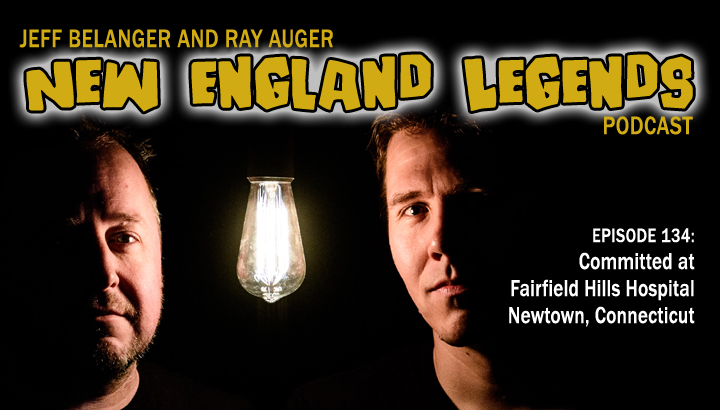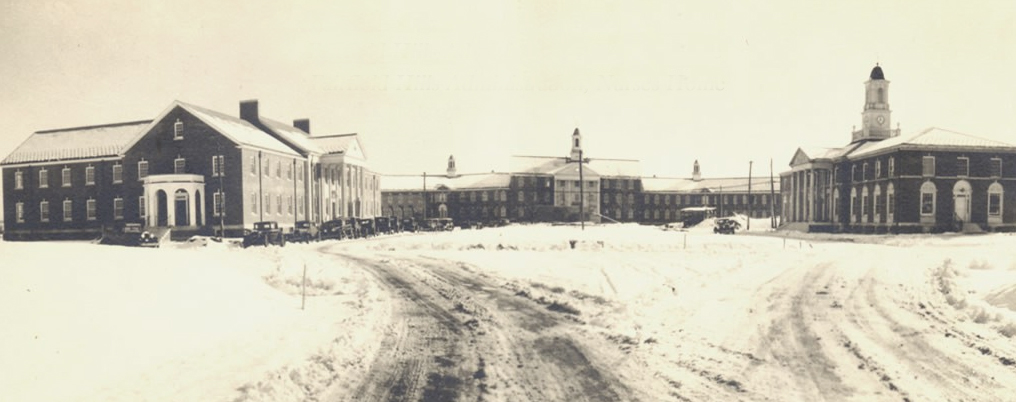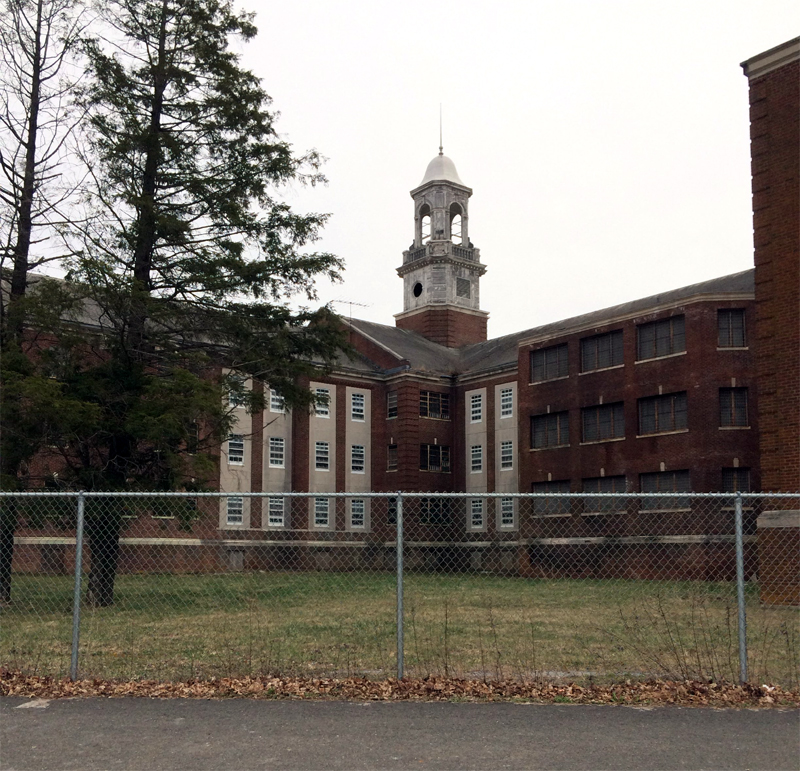
In Episode 134, Jeff Belanger and Ray Auger drive up to the remains of Fairfield Hills Mental Hospital in Newtown, Connecticut. Opened in 1933, Fairfield Hills was touted as the latest and greatest in the treatment of people whose “minds have become deranged with strange fancies, and who have lost control over their thoughts and emotions.” But overcrowding and underfunding lead to conditions that were truly horrific, conditions that haunt us decades later.
CALL (OR TEXT) OUR LEGEND LINE:
(617) 444-9683 – leave us a message with a question, experience, or story you want to share!
BECOME A LEGENDARY LISTENER PATRON:
https://www.patreon.com/NewEnglandLegends
CREDITS:
Produced and hosted by: Jeff Belanger and Ray Auger
Edited by: Ray Auger
Theme Music by: John Judd
SUBSCRIBE TO THE PODCAST FOR FREE:
Apple Podcasts/iTunes | Google Podcasts | Spotify | Stitcher | TuneIn | iHeartRadio | TuneIn | SoundCloud
JOIN OUR SUPER-SECRET:
New England Legends Facebook Group


EPISODE TRANSCRIPT:
*A note on the text: Please forgive punctuation, spelling, and grammar mistakes. Like us, the transcripts ain’t perfect.
[DRIVING ON ROAD]
JEFF: Ray, this is a trip down memory lane for me.
RAY: Right, you grew up in Newtown, Connecticut, didn’t you?
JEFF: I did. The Sandy Hook section to be exact. I fell in love with haunted history in this town. I remember going to sleepovers at some friends’ old houses… Houses they said were haunted.
RAY: Did you experience anything?
JEFF: We used to take out the Ouija board and try to make contact with whatever might be there.
RAY: So I guess you’re taking us to a haunt in town?
JEFF: Though this town has plenty of buildings that can lay claim to a ghost or two, I’m taking you to the mother of all Newtown haunts. It’s just at the top of this hill.
RAY: Woah! This place is huge! It looks almost like some old college campus… or….
JEFF: Or… a former asylum? Welcome to the haunted grounds of Fairfield Hills Hospital.
[INTRO]
JEFF: Hi, I’m Jeff Belanger.
RAY: And I’m Ray Auger. Welcome to Episode 134 of the New England Legends podcast. If you give us about ten minutes, we’ll give you something strange to talk about today.
JEFF: Thanks for riding with us as we chronicle every single legend in New England one story at a time. Each week we bring you strange but true tales of ghosts, monsters, aliens, and the just plain odd from all over the northeastern United States.
RAY: And we can’t do what we do without the support of our Patreon patrons. This show requires a ton of time and money each week to cover our production, hosting, and promotion costs. We do this because we know these stories bring people together. They connect us to our past, and to each other. If you can support what we do in a bigger way, head over to patreon.com/newenglandlegends and for just $3 bucks per month you get early access to new episodes plus bonus episodes that no one else gets to hear.
JEFF: Fairfield Hills Hospital is picturesque, isn’t it?
RAY: It is. It seems pretty busy, too. There’s a lot of cars around, I see a bunch of people going in and out of those buildings over there.
JEFF: Today several of these buildings are town offices. The town hall is that one, there’s an indoor sports complex, a school over there. Buuutt…
RAY: Oh wait, a couple of these large buildings look absolutely frightening. Clearly abandoned and empty. This big building next to us has a chain link fence around it.
JEFF: When I was growing up here in the 1980s and 90s, this was still an active, but run-down mental hospital. There weren’t a lot of patients still here, and some of the buildings had already been boarded up. But we used to play soccer on the fields outside these buildings and sometimes the patients would walk by and watch us.
RAY: Had you heard these buildings were haunted back then?
JEFF: I think everyone in town had heard about the haunted reputation. We knew there were tunnels underground connecting some of the buildings. And if you were ever practicing soccer out here on a weeknight at dusk, and if it was quiet, you could hear screams coming from inside the building.
[SCREAMS OF ANGUISH IN THE DISTANCE]
RAY: Couldn’t that have just been some of the patients?
JEFF: Definitely. I’m mostly sure it was some of the living patients. But man, it chilled you to the bone when you heard it. There was real anguish in those screams. And again, I’m only mostly sure it was the living patients. There’s still that piece of me that wonders.
RAY: Way back in the year 2000, this hospital was on an episode of MTV’s Fear. Ed and Lorraine Warren were in that episode. I remember the show freaked me out. What is it about these abandoned asylums that are always so damn scary?
JEFF: Let’s face it atrocities took place inside these buildings. Patients were neglected and abused. Plus, some of the treatments that the people inside this place used to receive are absolutely barbaric by today’s standards. And that haunts us.
RAY: Let’s head back to the 1930s and set this up.
[TRANSITION]
RAY: It’s June 21st, 1933, and Fairfield Hills Hospital has just opened to receive its first patients. Construction began almost three years ago, and now some of the buildings are ready for business. This is the state’s third mental hospital. It was needed because the other two are already filled beyond their capacity.
JEFF: This hospital is NOT a welcome addition to Newtown. As you can imagine, a project this big and costly doesn’t happen overnight. Newtown was selected years ago as the site, and the townsfolk weren’t happy. Could these patients be dangerous? What if they escape? What will it do to this quiet, rural town?
RAY: Still, hospitals like this are needed. And they have to go somewhere. And Newtown is it, like it or not. Dr. Roy Leak is the first superintendent of Fairfield Hills, and though he had years of experience working at Connecticut State Hospital in Middletown, he seems to have learned nothing as far as community relations goes. It’s tough to open any kind of new facility in a town that doesn’t want you and already doesn’t like you. Dr. Leak is taken off guard on Day One when he sees just how angry the locals are.
JEFF: Still, it’s too late now. The land has been purchased, patients are here, and more buildings are still under construction. And it turns out that community relations isn’t the only thing that Dr. Leak is not good at.
RAY: What do you mean?
JEFF: At this time there are now three hospitals in Connecticut to treat the mentally ill. There’s Norwich State Hospital, Connecticut State Hospital, and now Fairfield Hills. Fairfield Hills has been billed as not only the newest, but the very best in treating people whose quote “minds have become deranged with strange fancies, and who have lost control over their thoughts and emotions.” The other two state hospitals and their staff don’t take kindly to being told they’re inferior, so already there’s tension within the state, and very little communication between the three hospitals.
RAY: Which is a problem because Fairfield Hills is expected to take some patients from both of the other two hospitals.
JEFF: Exactly.
RAY: There are two dormitories available for patients right now. Shelton and Greenwich Houses. They’re meant to hold 500 patients between the two, and they’re already filling fast. From here we’re going to leap forward just one year to June of 1934.
[SFX TRANSITION]
RAY: It’s been one year, and Shelton and Greenwich Houses have been receiving a steady influx of patients from Norwich and Connecticut State Hospitals. There’s now 536 patients living in two buildings… building meant to hold 500.
JEFF: So in only one year, it’s already overcrowded. In addition to the patients, there are 136 staff members that includes: 4 physicians, 58 psychiatric attendants including nurses, and 76 other employees which would include office staff, cooks, groundskeepers, maintenance, and other people needed to run a big operation like this. By the end of year two, the patient count had dropped to 495 thanks to some being discharged, and others dying.
RAY: Obviously there’s a big need for this hospital considering it’s already at capacity, and they’re doing their best to finish Kent and Canaan Houses so they can bring in more patients. And then there’s the treatment the patients receive.
JEFF: Right, the treatment. By the late 1930 and early 1940s, electroshock therapy is en vogue in the psychiatric community.
[ELECTRIC SHOCKS]
JEFF: Doctors place electrodes on the temples of patients with severe schizophrenia, depression, or other serious mental disorders, and then deliver a shock to the temporal lobe. The idea is to induce a seizure in the patient. The thought is that a seizure is almost like a reboot of the brain and may help reduce or even stop some of the extreme behavior.
RAY: But man, this treatment is tough to watch. Some of the patients look like they’re in anguish!
JEFF: And it gets worse. In November of 1941, a patient dies during electroshock therapy. The death was peculiar enough that an autopsy is ordered, and then it’s discovered that the patient had actually died from being beaten to death. Five employees are fired, two are convicted of manslaughter, and one of assault. But electroshock therapy isn’t the only form of treatment that’s tough to watch here.
RAY: No, here in the 1940s, the use of restraints like straightjackets is also common for patients who are prone to hurting themselves and others. And given the population of the hospital is swelling, and the staff have only limited resources, sometimes patients spend many hours in these restraints as their arms go numb from a lack of circulation.
JEFF: There’s also insulin coma therapy, where physicians deliberately place patients into a low blood sugar coma. The coma was supposed to provide a brain reset and should only last one to four hours. But sometimes patients never pull out of these comas.
RAY: In 1941 alone, there are 86 deaths at Fairfield Hills Hospital. Some of these folks die from old age, others from illness, but then some are lost to suicide, accidents, and other darker causes.
JEFF: In May of 1946, Dr. Bernard Brody begins performing frontal lobotomies on the most destructive patients. Within the next year, 107 lobotomies are performed. Some patients seem to improve, others show no change at all, and four people die from complications of the surgery.
RAY: This all sounds so terrible!
JEFF: Look, no one wants to end up in an asylum. But for some people, this is the only place they can have any sort of quality of life. Some mental disorders are so extreme that people can’t be cared for in a home setting. They need 24-7 care and supervision by trained medical staff.
RAY: That’s for sure. But the problem arises as we keep moving forward in time. In 1949 Fairfield Hills Hospital population peaks at 2,650 patients. At this level, it’s a pretty tough environment. And to make matters worse, the hospital is now facing a staff turnover rate of 50%.
JEFF: Oh man. So basically one out of two employees is resigning, which means two things: first, this job is more than they can take. And two, the job is more than they can take because the facility is understaffed, and the patients are NOT receiving proper care. Seeing that up close can eat away at your own sanity and mental health. And suddenly, conditions go into a downward spiral.
RAY: So now we have patients who are already going through the torment of their mental health afflictions being underserved. Tensions build, and this place is like a powder keg. When a patient turns violent against another patient, and staff are short-handed already, a minor assault can turn into something much darker. And of course the other option is to restrain or lockup those prone to violence for way too long, which only makes a bad situation worse.
JEFF: By the late 1950s, the average number of deaths at Fairfield Hills Hospital is 346 people per year. That’s basically one person every. Single. Day.
RAY: Life, for better or worse, continues here at Fairfield Hills, but then something happens in the United States in the 1970s and 1980s. The government puts forth the deinstitutionalization initiative, which begins to empty out hospitals like Fairfield Hills. Funds are cut further, staff are cut, the amount of patients that can be served are cut, until everything dwindles.
JEFF: Buildings this large require a lot of upkeep. So the administration begins to shut them down one by one. The unused buildings are locked up and emptied. And though they’re empty, and decaying like some corpse in the woods, they still seem to have a story to tell. And that brings us back to today.
[TRANSITION]
JEFF: Ray, have you heard of the Stone Tape Theory?
RAY: I actually read up on this one. The Stone Tape Theory states that locations, especially those made of stone, can kind of psychically record events. And other people can pick up on those events, almost like tuning in to a radio station. Do you think that’s what’s happening here at Fairfield Hills?
JEFF: It could be. My childhood, and now the Internet are filled with stories of people breaking into the old buildings and seeing apparitions, or hearing screams in the distance. Sometimes when you know the history of these places and you step inside, and it’s dark, it’s quiet… you can’t help but tune into the emotions and feelings of the people who once lived here.
RAY: Okay, yeah, that gave me the chills. It must have been a horror show here at times.
JEFF: It must have been. The saddest part of this is that the story of Fairfield Hills Hospital is not unique by any means. This same story played out in asylums across the nation.
RAY: Where did all of the patients go?
JEFF: Some could be treated with better medicines and live on their own or with family, some made their way into assisted living facilities, but many of them sadly now account for our homeless and prison populations. Those folks have no other options.
RAY: That’s terrible!
JEFF: It is. But at least the story of the buildings of Fairfield Hills have a somewhat happy ending. By the time I was in high school, the few remaining buildings were shutting down for good. The town of Newtown purchased the property and its buildings from the state in 2007, and have turned them into the town hall, a school, a sports complex, and they still have plans for more development. The tunnels have been filled in, and I can’t imagine these remaining buildings will sit rotting that much longer.
RAY: That’s good, but still, you have to wonder when it’s dark, and late at night, if maybe you can still hear and experience a few echoes from this facility’s troubled past.
[SCREAM IN THE DISTANCE]
[OUTTRO]
JEFF: Thanks for the trip down memory lane, Ray!
RAY: Of course! I can only imagine what it must be like to live in a town with this imposing campus at the top of the hill.
JEFF: This place commanded attention, that’s for sure. Hey, if you love stories of the strange in New England, be sure to subscribe to our weekly podcast! It’s free, and you can do so on iTunes or Apple Podcasts, Google Podcasts, Stitcher, iHeartRadio, or wherever you get your podcasts.
RAY: We also love hearing from you! Please post a review of our show, share our episodes on your social media, or stop a stranger on the street. You can also call or text our legend line anytime at 617-444-9683. Send us your feedback and ideas, or leave our show closing on there for us.
JEFF: Just a reminder that the discussion about this episode continues in our New England Legends extra, which you can only get at patreon.com/newenglandlegends. And our theme music is by John Judd.
VOICESMAIL: Hi, this is Debbie from right here in Milford, Mass. Until next time remember the bizarre is closer than you think.
Copyright © 2020 New England Legends. All rights reserved.

My best friend died at the hospital around 1988, his name was John Crocket (Johnny, Johnathan).
In 1998 I was on a film shoot using inside the hospital, the movie is Blackmale (2000) directed by the Baluzy brothers. Once the sun went down and we had the scene lit… I took a deep breath and decided to see if Johnny was still there. As I walked down the hallway, with patient rooms off to the side, the light fell off and I entered one of the room in complete silence. My heart was pounding and I said out loud, Johnny if you are, give me sign. Nothing happened. But, the experience was terrifying because I’ve never asked a ghost to show itself, and I felt extremely vulnerable. Peace – Colin